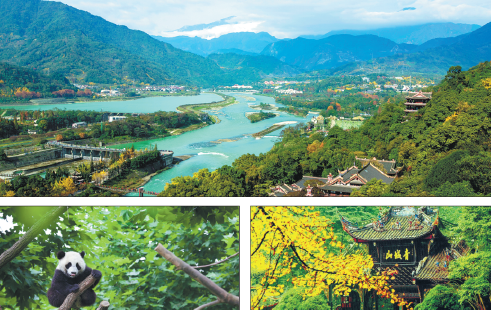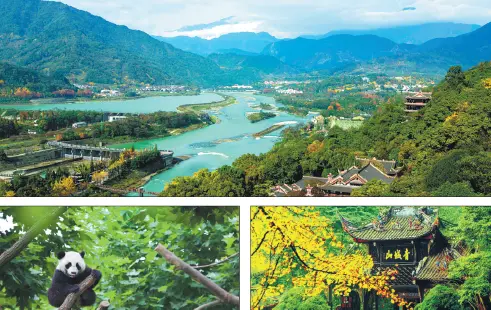The 31st International University Sports Federation Summer World University Games kicked off in Chengdu, the capital city of Southwest China's Sichuan province, on Friday.
Adhering to the principles of greenness, intelligence, vitality and sharing and following the "simple, safe and splendid" requirements, the Chengdu FISU Games showcases the youthful spirit of university students from around the world and demonstrates the vitality of Chengdu.
A popular tourist spot in Sichuan with a history of more than 2,000 years, Dujiangyan city boasts the world cultural heritage sites of the Qingcheng Mountain and the Dujiangyan Irrigation System as well as the world natural heritage site of the giant panda habitat.
Harmonious coexistence
The giant panda is a unique and rare species in China and one of the most internationally recognized symbols of the Chinese culture. Today, it has become the icon of Chengdu and the mascot Rongbao of the Chengdu FISU Games is created based on the image of a real panda named Zhima.
Dujiangyan is located at the intersection of the Minshan Mountains and Qionglai Mountains, with a forest coverage rate of 60.34 percent. It is an important part of the Giant Panda National Park and a natural corridor for the survival and reproduction of giant pandas.
For this reason, the Hollywood film series Kung Fu Panda chose Qingcheng Mountain in Dujiangyan as a shooting location.
The Giant Panda National Park was officially established in October 2021.
It has effectively enhanced the integrity and connectivity of the giant panda habitat and is of great significance for the stable growth of the wild giant panda population and the exchange of genes between populations.
In recent years, Dujiangyan, in order to fulfill its missions of protecting giant pandas, biodiversity conservation and ecological and environmental restoration, the Dujiangyan station of the Giant Panda National Park has made efforts in key areas such as resource protection, scientific research monitoring and nature education.
While protecting the giant pandas, it also protects biodiversity by preserving other species.
"Through reducing human disturbances and destruction and establishing reasonable protection measures through scientific research monitoring, the habitat environment of the giant panda is getting better, the population of giant pandas is steadily increasing, and the effectiveness of the protection is significant," said Zhu Dahai, director of the Longchi Conservation Station of the Dujiangyan Station of the Giant Panda National Park.
Shang Tao, director of the research institute of the management office of the Dujiangyan station at the Giant Panda National Park, said that the park follows the principle that "people retreat, pandas enter" and implements ecological restoration.
By establishing artificial water points and creating artificial caves, the area has improved the habitat for wild animals, constructed biodiversity conservation networks and enhanced the ecological barrier of Longmen Mountain.
"In the future, we will improve the small and medium-sized habitats and biological migration corridors and continue to promote the ecological restoration of 1,133.33 hectares of giant panda habitat in Longmen Mountain. We will launch projects for the ecological restoration of the Changheba area and the Liangchahe area. Our aim is to continuously improve the habitat environment of the giant panda corridor, making the biodiversity in this area richer and achieving a harmonious coexistence between humans and nature," said Shang.
In addition to the Giant Panda National Park, Dujiangyan also houses the Giant Panda Valley, which is the Dujiangyan giant panda breeding and wildlife research center at the Chengdu Research Base of Giant Panda Breeding, and the Dujiangyan base of the China Conservation and Research Center for Giant Pandas, which is known as the Panda Paradise.
Land of abundance
One of the oldest, largest and most well-preserved irrigation projects in the world, Dujiangyan was inscribed as a UNESCO World Heritage Site in January 2000.
In April, the Polish and US delegations, who came to Chengdu to participate in the Heads of Delegation Meeting of the Chengdu 2021 FISU World University Games, visited Dujiangyan. In the Dujiangyan scenic area, the delegations viewed the whole water conservancy project from Qinyan Tower and visited three major projects of the Dujiangyan headworks, namely the Yuzui Bypass Dike, the Feishayan Floodgate and the Baopingkou Diversion Passage. The two delegations displayed great interest in the ancient engineering work and learned about the principles and functions of the water conservancy project.
"I am very much in awe of the wisdom of the ancient Chinese people more than 2,000 years ago who designed and built the Dujiangyan water conservancy project for the benefit of the people," said Olsen Ronald Paul of the US delegation.
Dujiangyan was built at the same time as the Great Wall of China and still guards and nourishes the Chengdu Plain. During the late reign of King Zhao of Qin(approximately 276 BC to 251 BC), Li Bing, governor of Shu county, summarized the experience of his predecessors in water control and took charge of the construction of Dujiangyan, turning the Chengdu Plain into a Land of Abundance where "water and drought follow human command, and there is no hunger".
Jiang Weiwei, Party secretary of Dujiangyan, said that the Dujiangyan water conservancy project manifests the same simple, safe and splendid requirements as the Chengdu FISU Games. He said that in terms of simplicity, the project adopts a no-dam diversion method irrigating 753,333 hectares of fertile land and benefiting seven cities and over 30 million people. It is an exemplary project of simplicity, as it is well constructed, with low maintenance costs and high cost-effectiveness.
For safety, the project ensures that there are no water disasters or droughts in the entire Chengdu Plain, guaranteeing food security. Dujiangyan plays a crucial role in ensuring the safety of the Chengdu Plain and even the Chinese nation. And for the splendid feature, he added, Dujiangyan is not only an ancient project with a history of more than 2,000 years, but also a modern-day endeavor that irrigates the Land of Abundance. The Dujiangyan water conservancy project embodies the concept of following the natural order and showcasing people's wisdom in ancient times.

Clockwise from top: Dujiangyan irrigation project boasts a history of more than 2,000 years. The scenery of Qingcheng Mountain in Chengdu city of Sichuan province. A giant panda lives in the Panda Paradise in Dujiangyan. CHINA DAILY
(CHINADAILY)
 简体中文
简体中文

